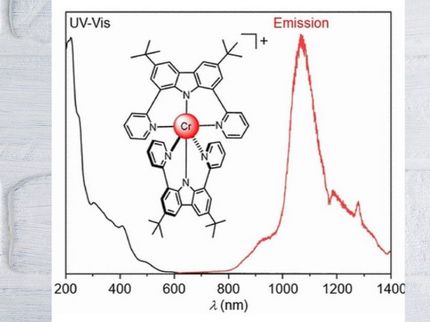Europium complexes emit red light at record efficiency
Researchers worldwide continue search for better luminescent materials for OLED manufacturing. Two new compounds with europium complexes developed at the Institute of Physical Chemistry of the Polish Academy of Sciences in Warsaw display in their class record high luminescence efficiencies in red, and their properties enable faster, low cost manufacturing of thin OLED films.
Researchers from the Institute of Physical Chemistry of the Polish Academy of Sciences (IPC PAS) in Warsaw developed two new materials with record high luminescence efficiency. The compounds were prepared using phosphine oxides (oxidised organic compounds containing phosphorous-carbon bonds) as co-ligands in europium ion-based complexes. A research group from Scotland's University of St. Andrews collaborating with the IPC PAS used the developed compounds to build prototype OLEDs generating nearly monochromatic red light.
"Both compounds, carefully designed by us, display in their class a record-breaking luminescence efficiency. As a matter of fact, we know red emitters with somewhat higher efficiency, containing iridium, but it's completely different type of materials", notices Prof. Marek Pietraszkiewicz from the IPC PAS.
Red light emitted by europium complexes with phosphine oxides is of well-defined wavelength, about 612 nanometer (a billionth part of a meter). The luminescence quantum yields of these compounds reach 90%.
"A narrow emission wavelength range and the record-breaking efficiency result from our approach to molecular design. We attach extended, highly rigid phosphine oxides to europium complexes. As a result, the energy delivered to the molecule is not dissipated in unnecessary vibrations or rotations. Instead of delivering heat to the surrounding we have higher efficiency and virtually monochromatic light", explains Michał Maciejczyk, a doctoral student from the International Doctoral Studies at the IPC PAS.
An important advantage of the luminescent materials developed and produced in the IPC PAS is their stability – they do not degrade when exposed to oxygen or light. Equally important is, however, the possibility to produce films of these materials from solutions. Existing manufacturing technologies for production of OLED films required usually the use of high vacuum evaporation and deposition. The vacuum deposition technique is very expensive, troublesome, and not everywhere available. It also requires that material is warmed up to 200-300 degrees centigrade, a temperature not well-tolerated by all compounds. The problems disappear when the films can be deposited directly from solution – and this is possible for phosphine oxides with europium complexes.
Potential applications of the new materials include not only OLED displays or lighting components, such as rear lights of mechanical vehicles, but also flexible elastic dermal patches for use in anticancer therapies. The europium complex-based compounds incorporated in such patches would generate light of exactly known wavelength that could locally activate appropriately selected active ingredients, delivered earlier with other methods to patient's ill skin cells. During therapy, the dermal patch would require only a small power supply from a battery. Patient mobility would be minimally affected, and hospitalisation would not be needed any longer.
Most read news
Topics
Organizations
Other news from the department science

Get the chemical industry in your inbox
From now on, don't miss a thing: Our newsletter for the chemical industry, analytics, lab technology and process engineering brings you up to date every Tuesday and Thursday. The latest industry news, product highlights and innovations - compact and easy to understand in your inbox. Researched by us so you don't have to.





























































